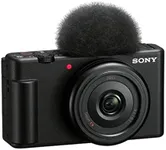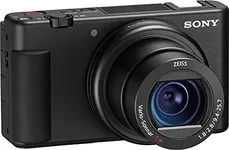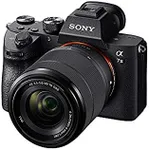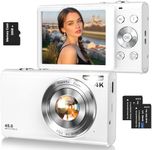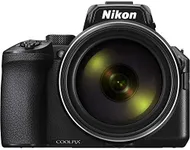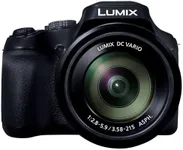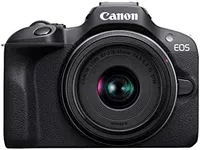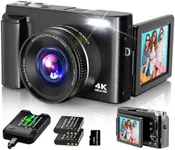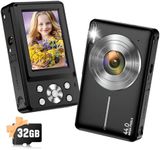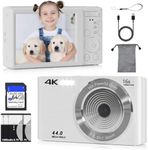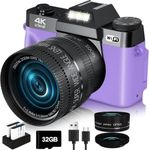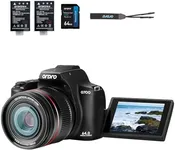Buying Guide for the Best Cameras For Photography Beginners
Choosing the right camera as a beginner in photography can be a bit overwhelming due to the variety of options available. The key is to find a camera that balances ease of use with the ability to grow as your skills improve. Start by understanding the basic features and specifications that matter most for beginners. This will help you make an informed decision and ensure that your camera meets your needs as you learn and develop your photography skills.Sensor SizeThe sensor size in a camera determines the quality of the images it can produce. Larger sensors generally capture more light and detail, resulting in better image quality, especially in low light conditions. Common sensor sizes include Full Frame, APS-C, and Micro Four Thirds. Full Frame sensors are the largest and offer the best quality, but they are also more expensive and bulkier. APS-C sensors are smaller but still provide excellent quality and are more affordable and compact, making them a good choice for beginners. Micro Four Thirds sensors are even smaller and more portable, but they may not perform as well in low light. Consider your need for image quality versus portability when choosing a sensor size.
MegapixelsMegapixels refer to the resolution of the camera's sensor, indicating how many millions of pixels the camera can capture. Higher megapixels mean more detail in your photos, which is important if you plan to print large photos or crop images without losing quality. For beginners, a camera with 16 to 24 megapixels is usually sufficient, providing a good balance between image quality and file size. Unless you have specific needs for very high-resolution images, you don't need to prioritize the highest megapixel count.
Lens CompatibilityLens compatibility refers to the range of lenses that can be used with a camera. Interchangeable lens cameras, such as DSLRs and mirrorless cameras, offer the flexibility to change lenses based on your photography needs. This is important for beginners who want to experiment with different types of photography, such as portraits, landscapes, or macro. Ensure that the camera you choose has a good selection of lenses available, and consider starting with a versatile kit lens that covers a range of focal lengths.
Ease of UseEase of use is crucial for beginners who are still learning the basics of photography. Look for a camera with a user-friendly interface, intuitive controls, and helpful features like guided modes or tutorials. Cameras with touchscreen interfaces can be easier to navigate, and those with physical dials and buttons can provide quick access to important settings. Consider how comfortable you feel using the camera and whether it offers features that help you learn and improve your skills.
Autofocus SystemThe autofocus system determines how quickly and accurately the camera can focus on a subject. A good autofocus system is important for capturing sharp images, especially in fast-moving or low-light situations. For beginners, look for a camera with a reliable and easy-to-use autofocus system. Cameras with more autofocus points and advanced tracking features can provide better performance, but even basic systems can be sufficient for general photography. Consider your needs and the types of subjects you plan to photograph when evaluating autofocus systems.
Image StabilizationImage stabilization helps reduce blur caused by camera shake, allowing you to take sharper photos, especially in low light or when using longer focal lengths. There are two types of image stabilization: in-body and lens-based. In-body stabilization works with any lens attached to the camera, while lens-based stabilization is specific to certain lenses. For beginners, having image stabilization can be very helpful, but it's not a deal-breaker if the camera or lens you choose doesn't have it. Consider how often you shoot in low light or without a tripod when deciding if this feature is important for you.
Video CapabilitiesMany modern cameras offer video recording capabilities, which can be a valuable feature for beginners who want to explore videography. Look for a camera that can record at least Full HD (1080p) video, as this provides good quality for most purposes. Some cameras also offer 4K video, which provides higher resolution but results in larger file sizes. Consider whether you plan to use the camera for video as well as photography, and choose a model that meets your needs in both areas.
Battery LifeBattery life is an important consideration, especially if you plan to use your camera for extended periods or while traveling. Cameras with longer battery life allow you to shoot more photos and videos without needing to recharge or carry extra batteries. DSLRs typically have longer battery life compared to mirrorless cameras, but this can vary between models. Check the manufacturer's specifications for the estimated number of shots per charge and consider your shooting habits when evaluating battery life.
ConnectivityConnectivity features, such as Wi-Fi, Bluetooth, and NFC, allow you to easily transfer photos and videos from your camera to other devices, such as smartphones, tablets, or computers. This can be convenient for sharing your work on social media or backing up your files. Some cameras also offer remote control capabilities via a smartphone app, which can be useful for self-portraits or group shots. Consider how important these features are to you and whether the camera you choose offers the connectivity options you need.


